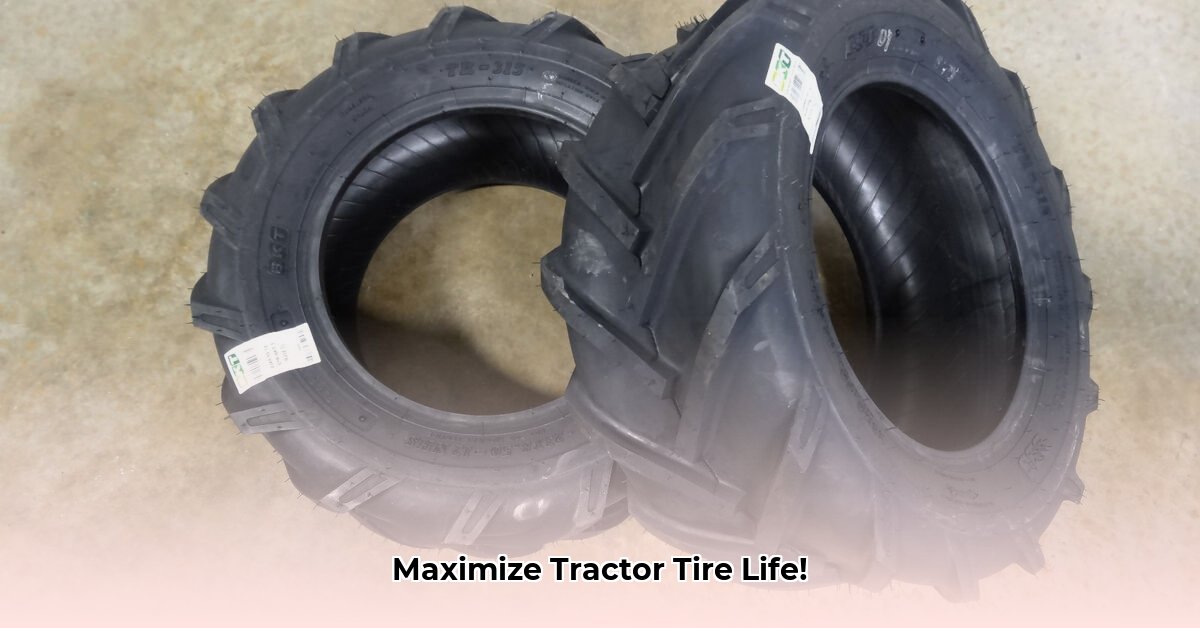
Picking the right tires for your tractor significantly impacts farm efficiency and environmental sustainability. This guide focuses on maximizing the performance and longevity of 23x8.50-12 tractor tires while minimizing soil compaction and promoting sustainable farming practices. We'll cover tire specifications, pressure optimization, maintenance, sustainable alternatives, and responsible disposal. For more tire size options, check out this helpful resource: other tractor tire sizes.
Understanding 23x8.50-12 Tractor Tire Specifications
The numbers "23x8.50-12" specify the tire's dimensions and capabilities. "23" indicates the diameter (in inches), "8.50" the width, and "12" the rim diameter. A wider tire (larger 8.50 number) distributes weight more effectively, reducing soil compaction. This is crucial for sustainable agriculture, as compacted soil hinders water absorption and reduces crop yields. Understanding these specifications is the first step towards minimizing your farm's environmental footprint.
Optimizing Tire Pressure for Various Soil Conditions
Correct tire pressure is paramount. Too much pressure compacts soil; too little results in poor traction and fuel inefficiency. Pressure should be adjusted based on three primary factors: soil type, moisture content, and the type of farming operation.
Soil Type: Clay soils, being denser, require lower pressure (around 14-18 PSI when wet) to avoid compaction compared to sandy soils (16-20 PSI when wet), which can tolerate slightly higher pressure. Loam soils fall between these extremes (15-19 PSI when wet).
Moisture Content: Wet soil is more vulnerable to compaction, warranting lower pressures than dry soil. Always adjust pressure according to the soil's moisture level.
Farming Operation: Heavier operations, such as plowing, necessitate higher pressures than lighter tasks, like spraying. Consider the specific demands of the operation when determining the optimal pressure.
Don't forget regular pressure checks! A properly inflated tire conserves fuel and preserves soil health. Isn't fuel efficiency a key consideration for both your bottom line and the environment?
| Soil Type | Moisture Condition | Operation | Suggested Tire Pressure (PSI) |
|---|---|---|---|
| Clay | Dry | General | 18-22 |
| Clay | Wet | General | 14-18 |
| Sandy | Dry | General | 20-24 |
| Sandy | Wet | General | 16-20 |
| Loam | Dry | General | 18-22 |
| Loam | Wet | General | 15-19 |
Note: These are guidelines; always consult your tractor's manual for precise recommendations.
Tire Maintenance and Longevity: A Practical Guide
Proactive maintenance maximizes tire lifespan and reduces waste. Here's a step-by-step approach:
- Weekly Inspections: Regularly check for cuts, punctures, embedded objects, or unusual wear patterns. Early detection prevents minor issues from becoming major repairs.
- Regular Pressure Checks: Consistent pressure monitoring is crucial. Adjust as needed based on soil conditions and operational demands.
- Thorough Cleaning: Remove mud and debris to prevent premature wear.
- Tire Rotation: Rotate your tires regularly to ensure even wear and extend their lifespan. This simple step significantly impacts tire longevity.
- Appropriate Storage: Store tires in a cool, dry place, protected from sunlight and harsh chemicals when not in use.
These simple steps significantly extend tire life, saving you money and minimizing environmental impact. Isn't preventative maintenance a cornerstone of sustainable farming?
Exploring Sustainable Tire Alternatives
The agricultural sector is embracing more eco-friendly tire options. Tires made from recycled materials or with enhanced tread designs to minimize soil compaction offer demonstrable sustainability gains. Although the initial cost might be higher, the long-term benefits in terms of soil health, fuel efficiency, and reduced environmental impact are significant.
"Choosing sustainable tires is an investment in the future of our farms and the planet," states Dr. Emily Carter, Agricultural Engineer, University of California, Davis.
Responsible Disposal and Recycling
At the end of their lifespan, dispose of tires responsibly. Many recycling programs accept used tires, reclaiming valuable materials and preventing landfill waste. Check with your local waste management facilities for available recycling options.
Case Study: Maximizing 23x8.50-12 Tire Performance in Sustainable Farming
A small vineyard in Napa Valley reported a 15% increase in fuel efficiency and a 10% reduction in soil compaction after implementing a comprehensive tire management strategy focused on proper inflation and regular maintenance of their 23x8.50-12 tires. This demonstrates the tangible benefits of proper tire management in sustainable agriculture.
Conclusion: Optimizing for Sustainability and Efficiency
Choosing the right tires and implementing a proactive maintenance plan are critical to successful sustainable farming. By understanding tire specifications, optimizing pressure, performing routine maintenance, and selecting sustainable options, farmers can minimize soil compaction, improve fuel efficiency, and reduce their environmental impact. Remember, sustainable practices aren't just about environmental responsibility; they also contribute to long-term economic success.